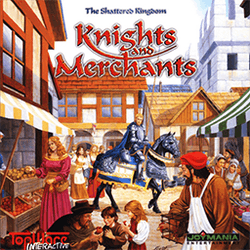Knights and Merchants: The Shattered Kingdom
| Knights and Merchants: The Shattered Kingdom | |
|---|---|
 | |
| Developer(s) | Joymania Entertainment |
| Publisher(s) | |
| Designer(s) | Peter Ohlmann, Adam Sprys |
| Platform(s) |
Windows MorphOS Mac OS Linux |
| Release date(s) |
Windows
Linux |
| Genre(s) | Real-time strategy |
| Mode(s) | Single-player, multiplayer |
Knights and Merchants: The Shattered Kingdom is a medieval-time based real-time strategy (RTS) video game. It was developed by Joymania Entertainment (since changed to Joymania Development) and published by TopWare Interactive in 1998. The player takes the role of the captain of the palace guards and leads the soldiers and citizens to victory. The game did not receive a strong critical or popular reception in the UK and the US, but elsewhere it was more popular. An expansion pack was released in 2001 titled Knights and Merchants: The Peasants Rebellion.
Gameplay
Knights and Merchants: The Shattered Kingdom has a single-player campaign that consists of 20 scenarios with scenario length ranging from around 5 minutes up to 7 hours or more depending on difficulty.
The game offers a multiplayer mode by using either IPX, TCP/IP or Modem where up to 6 players can play. There are 10 different scenarios to choose from including a number which focus specifically on the combat element of the game.
Plot
Knights and Merchants recreates the era of the Middle Ages. Apart from the purely fictitious geography of our world, all game elements and scenes are based on the European, but more particularly, the Anglo-Saxon period, around 1200 A.D.[1]
Economy
The economy is very complex in Knights and Merchants: The Shattered Kingdom, more so than most other RTS games, with a greater range of resources and a need to combine basic resources in a number of ways to create a functioning economy. For example, in order to get loaves of bread, the player is required to first build a farm to get wheat, then a mill to get flour and also a bakery to bake loaves of the flour. The many different resources in the game require a large amount of corresponding buildings and units in order to fully utilize them requiring greater than usual micromanaging for an RTS.
Every citizen and soldier must eat in the game meaning that the player needs to produce a great deal of food creating a more naturalistic limit on army size. There is no population limit in game, instead population is limited by how much food is produced. If a unit is not fed for a sustained amount of time it will die.
The everyday life aspect of this game is considered a notable feature. Many different structures can be placed, forcing the player to consider where and when to place each structure, this is also dependent on terrain and territory. However, for new players this greater complexity can lead to a process of trial and error but once experience has been gained it becomes an interesting take on RTS economics.
Expansion pack
Knights and Merchants: The Peasants Rebellion is a standalone expansion pack. It includes the 20 original missions (although the Russian release doesn't include the original campaign) as well as a brand new campaign that consists of 14 missions, a scenario mode with 10 different scenarios, and new buildings and units. The game was released in 2001 for Windows, but only in a few countries. Later in 2002 it was released in additional countries and in 2005 it was finally released in the U.S. The game has not been released in the UK.
Gameplay
The game's tech tree is simple and straightforward, and most new technology is accessed upon new building completion. To begin, the player can only build a school house that trains basic workers, but as the game advances more buildings and units become available. When playing a scenario or multiplayer mode, the player's technological advancement is not restricted, however in the single-player campaign some buildings cannot be built until the player progresses to later missions. The AI always begins with a technological advantage against the player, allowing them to develop at a higher level.
The economy in The Peasants Rebellion is complex, stemming from the game's variety of resources, ranging from wood and stone, to sausages and wine. Many resources need to be transported to other buildings to be refined, and then delivered - which presents the challenge of building placement and interconnecting (every building has to be connected by roads) as the player develops.
The citizens in The Peasants Rebellion get hungry - from workers, to farmers, to soldiers. This creates a challenging dynamic for the player - between managing combat, resource gathering, city building, as well as making sure there is a stable food supply for all the units. Unlike many other RTS games, Knights and Merchants: The Peasants Rebellion has no unit cap - aside from limited map size and hunger features, which help to limit the player's sustainable unit numbers.
Multiplayer mode in the original game was completely broken with the game going badly out of sync,[2] and only fixed in the fan remake.
Fan remakes
Several attempts[3] were made to extend game engine's capabilities and fix its bugs. The latest and largest currently are the unofficial 1.6 Patch.[4]
The whole engine rewrite was also made, called KaM Remake,[5] it includes complete original game experience expanded with multiplayer mode, map editor, additional campaigns and buildings.
References
- ↑ http://www.knights.de/us/
- ↑ Knights and Merchants NET :: The Peasants Rebellion Information
- ↑ Fan Creations – Knights and Merchants NET
- ↑ Knights and Merchants NET :: Fan Creations - 1.6 Patch
- ↑ About « KaM Remake
External links
- KaMRemakefan (youtube)
- Official website
- Knights and Merchants: The Shattered Kingdom at MobyGames
- Knights and Merchants: The Peasants Rebellion at MobyGames
- Developer Joymania Development at the Wayback Machine (archived August 22, 2010)
- Linux port